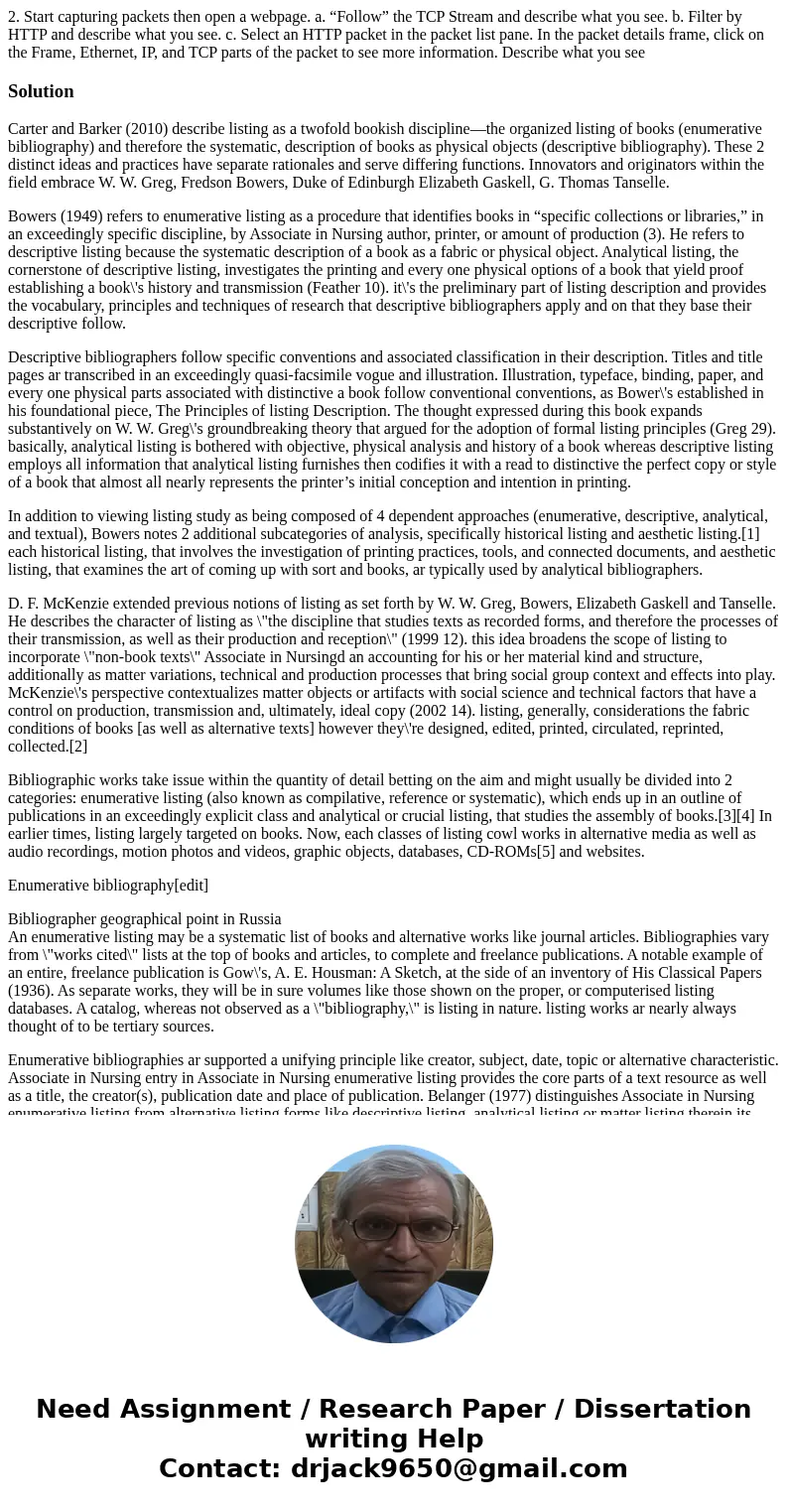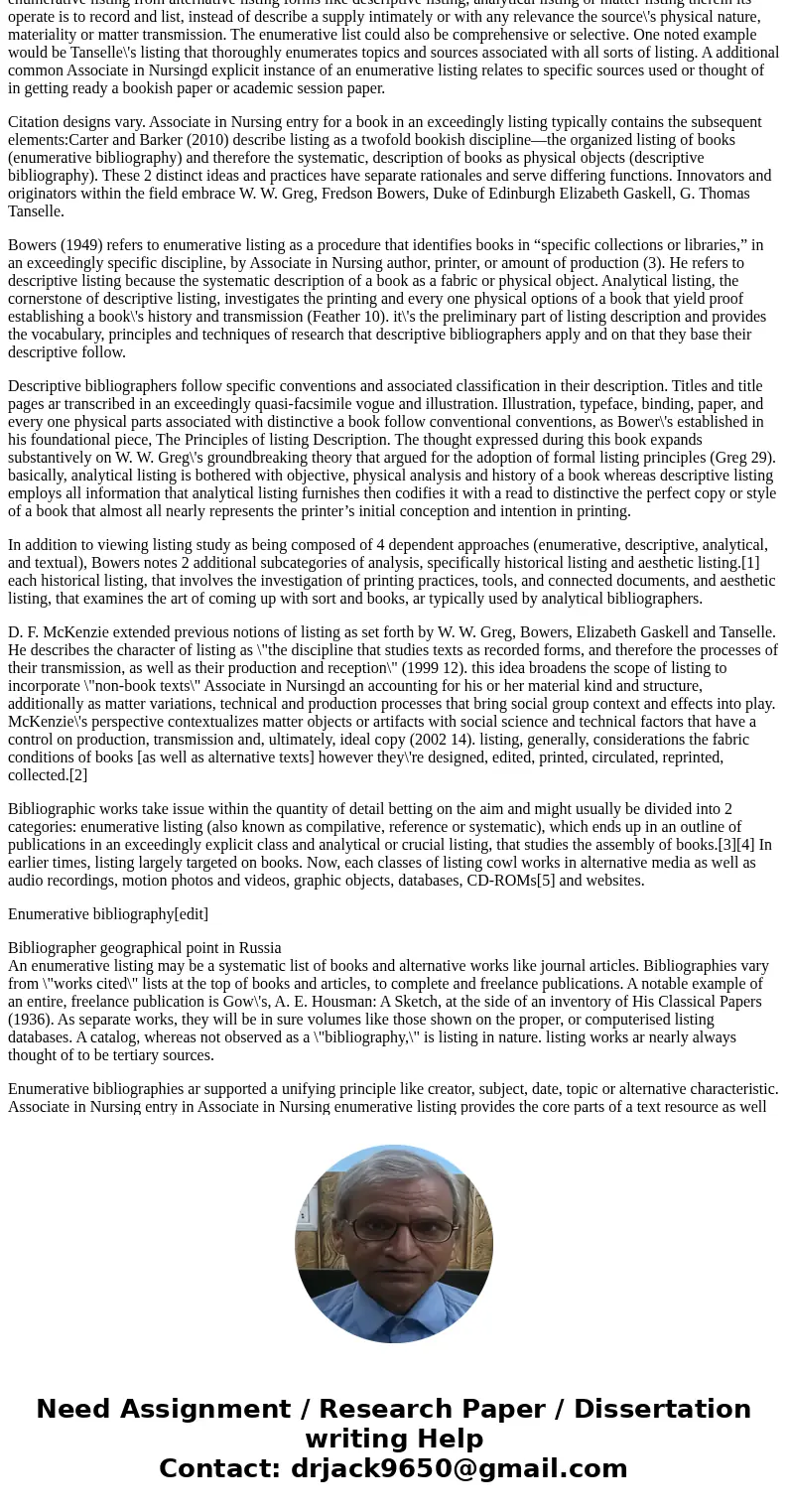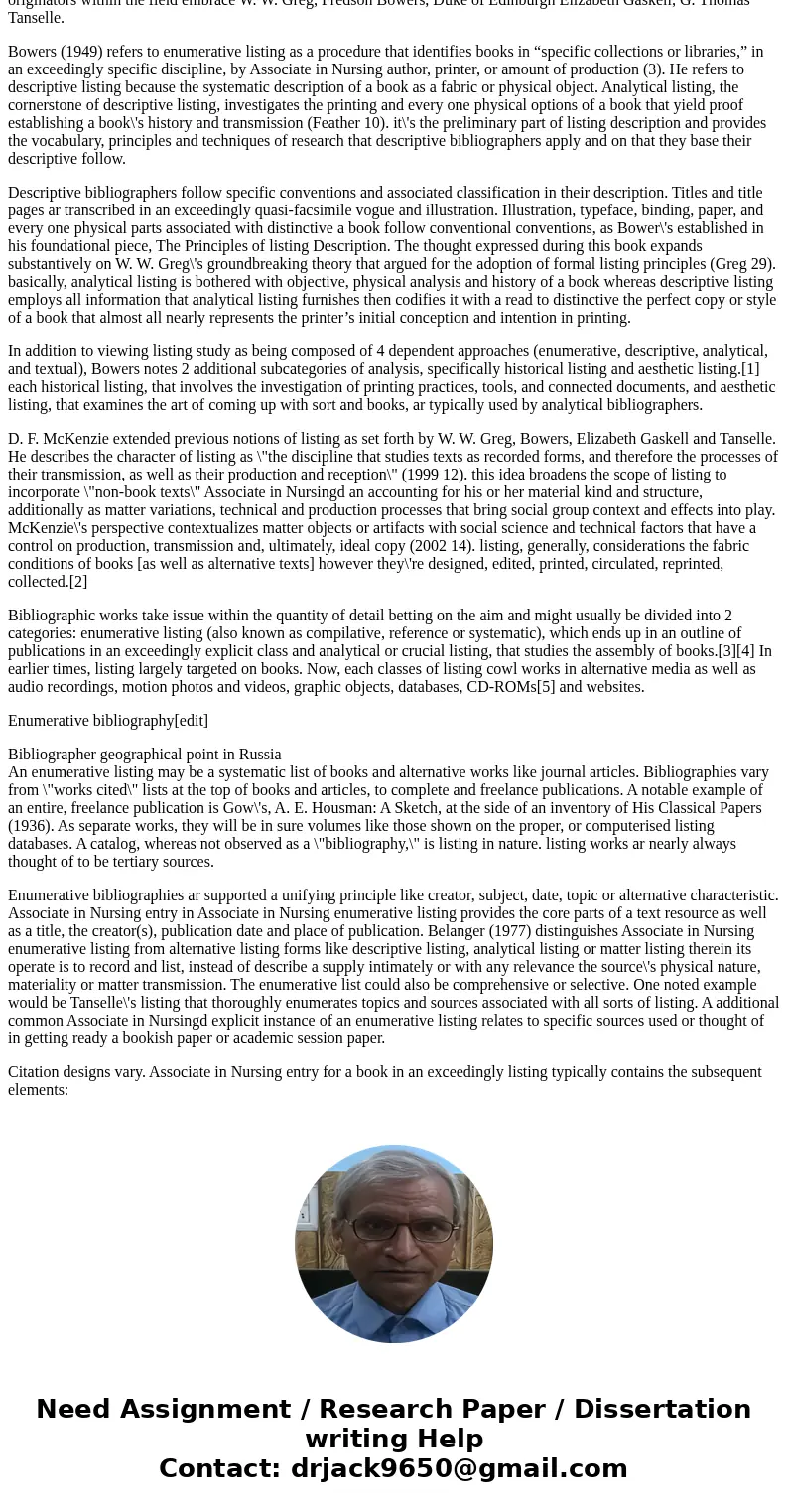2 Start capturing packets then open a webpage a Follow the T
2. Start capturing packets then open a webpage. a. “Follow” the TCP Stream and describe what you see. b. Filter by HTTP and describe what you see. c. Select an HTTP packet in the packet list pane. In the packet details frame, click on the Frame, Ethernet, IP, and TCP parts of the packet to see more information. Describe what you see
Solution
Carter and Barker (2010) describe listing as a twofold bookish discipline—the organized listing of books (enumerative bibliography) and therefore the systematic, description of books as physical objects (descriptive bibliography). These 2 distinct ideas and practices have separate rationales and serve differing functions. Innovators and originators within the field embrace W. W. Greg, Fredson Bowers, Duke of Edinburgh Elizabeth Gaskell, G. Thomas Tanselle.
Bowers (1949) refers to enumerative listing as a procedure that identifies books in “specific collections or libraries,” in an exceedingly specific discipline, by Associate in Nursing author, printer, or amount of production (3). He refers to descriptive listing because the systematic description of a book as a fabric or physical object. Analytical listing, the cornerstone of descriptive listing, investigates the printing and every one physical options of a book that yield proof establishing a book\'s history and transmission (Feather 10). it\'s the preliminary part of listing description and provides the vocabulary, principles and techniques of research that descriptive bibliographers apply and on that they base their descriptive follow.
Descriptive bibliographers follow specific conventions and associated classification in their description. Titles and title pages ar transcribed in an exceedingly quasi-facsimile vogue and illustration. Illustration, typeface, binding, paper, and every one physical parts associated with distinctive a book follow conventional conventions, as Bower\'s established in his foundational piece, The Principles of listing Description. The thought expressed during this book expands substantively on W. W. Greg\'s groundbreaking theory that argued for the adoption of formal listing principles (Greg 29). basically, analytical listing is bothered with objective, physical analysis and history of a book whereas descriptive listing employs all information that analytical listing furnishes then codifies it with a read to distinctive the perfect copy or style of a book that almost all nearly represents the printer’s initial conception and intention in printing.
In addition to viewing listing study as being composed of 4 dependent approaches (enumerative, descriptive, analytical, and textual), Bowers notes 2 additional subcategories of analysis, specifically historical listing and aesthetic listing.[1] each historical listing, that involves the investigation of printing practices, tools, and connected documents, and aesthetic listing, that examines the art of coming up with sort and books, ar typically used by analytical bibliographers.
D. F. McKenzie extended previous notions of listing as set forth by W. W. Greg, Bowers, Elizabeth Gaskell and Tanselle. He describes the character of listing as \"the discipline that studies texts as recorded forms, and therefore the processes of their transmission, as well as their production and reception\" (1999 12). this idea broadens the scope of listing to incorporate \"non-book texts\" Associate in Nursingd an accounting for his or her material kind and structure, additionally as matter variations, technical and production processes that bring social group context and effects into play. McKenzie\'s perspective contextualizes matter objects or artifacts with social science and technical factors that have a control on production, transmission and, ultimately, ideal copy (2002 14). listing, generally, considerations the fabric conditions of books [as well as alternative texts] however they\'re designed, edited, printed, circulated, reprinted, collected.[2]
Bibliographic works take issue within the quantity of detail betting on the aim and might usually be divided into 2 categories: enumerative listing (also known as compilative, reference or systematic), which ends up in an outline of publications in an exceedingly explicit class and analytical or crucial listing, that studies the assembly of books.[3][4] In earlier times, listing largely targeted on books. Now, each classes of listing cowl works in alternative media as well as audio recordings, motion photos and videos, graphic objects, databases, CD-ROMs[5] and websites.
Enumerative bibliography[edit]
Bibliographer geographical point in Russia
An enumerative listing may be a systematic list of books and alternative works like journal articles. Bibliographies vary from \"works cited\" lists at the top of books and articles, to complete and freelance publications. A notable example of an entire, freelance publication is Gow\'s, A. E. Housman: A Sketch, at the side of an inventory of His Classical Papers (1936). As separate works, they will be in sure volumes like those shown on the proper, or computerised listing databases. A catalog, whereas not observed as a \"bibliography,\" is listing in nature. listing works ar nearly always thought of to be tertiary sources.
Enumerative bibliographies ar supported a unifying principle like creator, subject, date, topic or alternative characteristic. Associate in Nursing entry in Associate in Nursing enumerative listing provides the core parts of a text resource as well as a title, the creator(s), publication date and place of publication. Belanger (1977) distinguishes Associate in Nursing enumerative listing from alternative listing forms like descriptive listing, analytical listing or matter listing therein its operate is to record and list, instead of describe a supply intimately or with any relevance the source\'s physical nature, materiality or matter transmission. The enumerative list could also be comprehensive or selective. One noted example would be Tanselle\'s listing that thoroughly enumerates topics and sources associated with all sorts of listing. A additional common Associate in Nursingd explicit instance of an enumerative listing relates to specific sources used or thought of in getting ready a bookish paper or academic session paper.
Citation designs vary. Associate in Nursing entry for a book in an exceedingly listing typically contains the subsequent elements:Carter and Barker (2010) describe listing as a twofold bookish discipline—the organized listing of books (enumerative bibliography) and therefore the systematic, description of books as physical objects (descriptive bibliography). These 2 distinct ideas and practices have separate rationales and serve differing functions. Innovators and originators within the field embrace W. W. Greg, Fredson Bowers, Duke of Edinburgh Elizabeth Gaskell, G. Thomas Tanselle.
Bowers (1949) refers to enumerative listing as a procedure that identifies books in “specific collections or libraries,” in an exceedingly specific discipline, by Associate in Nursing author, printer, or amount of production (3). He refers to descriptive listing because the systematic description of a book as a fabric or physical object. Analytical listing, the cornerstone of descriptive listing, investigates the printing and every one physical options of a book that yield proof establishing a book\'s history and transmission (Feather 10). it\'s the preliminary part of listing description and provides the vocabulary, principles and techniques of research that descriptive bibliographers apply and on that they base their descriptive follow.
Descriptive bibliographers follow specific conventions and associated classification in their description. Titles and title pages ar transcribed in an exceedingly quasi-facsimile vogue and illustration. Illustration, typeface, binding, paper, and every one physical parts associated with distinctive a book follow conventional conventions, as Bower\'s established in his foundational piece, The Principles of listing Description. The thought expressed during this book expands substantively on W. W. Greg\'s groundbreaking theory that argued for the adoption of formal listing principles (Greg 29). basically, analytical listing is bothered with objective, physical analysis and history of a book whereas descriptive listing employs all information that analytical listing furnishes then codifies it with a read to distinctive the perfect copy or style of a book that almost all nearly represents the printer’s initial conception and intention in printing.
In addition to viewing listing study as being composed of 4 dependent approaches (enumerative, descriptive, analytical, and textual), Bowers notes 2 additional subcategories of analysis, specifically historical listing and aesthetic listing.[1] each historical listing, that involves the investigation of printing practices, tools, and connected documents, and aesthetic listing, that examines the art of coming up with sort and books, ar typically used by analytical bibliographers.
D. F. McKenzie extended previous notions of listing as set forth by W. W. Greg, Bowers, Elizabeth Gaskell and Tanselle. He describes the character of listing as \"the discipline that studies texts as recorded forms, and therefore the processes of their transmission, as well as their production and reception\" (1999 12). this idea broadens the scope of listing to incorporate \"non-book texts\" Associate in Nursingd an accounting for his or her material kind and structure, additionally as matter variations, technical and production processes that bring social group context and effects into play. McKenzie\'s perspective contextualizes matter objects or artifacts with social science and technical factors that have a control on production, transmission and, ultimately, ideal copy (2002 14). listing, generally, considerations the fabric conditions of books [as well as alternative texts] however they\'re designed, edited, printed, circulated, reprinted, collected.[2]
Bibliographic works take issue within the quantity of detail betting on the aim and might usually be divided into 2 categories: enumerative listing (also known as compilative, reference or systematic), which ends up in an outline of publications in an exceedingly explicit class and analytical or crucial listing, that studies the assembly of books.[3][4] In earlier times, listing largely targeted on books. Now, each classes of listing cowl works in alternative media as well as audio recordings, motion photos and videos, graphic objects, databases, CD-ROMs[5] and websites.
Enumerative bibliography[edit]
Bibliographer geographical point in Russia
An enumerative listing may be a systematic list of books and alternative works like journal articles. Bibliographies vary from \"works cited\" lists at the top of books and articles, to complete and freelance publications. A notable example of an entire, freelance publication is Gow\'s, A. E. Housman: A Sketch, at the side of an inventory of His Classical Papers (1936). As separate works, they will be in sure volumes like those shown on the proper, or computerised listing databases. A catalog, whereas not observed as a \"bibliography,\" is listing in nature. listing works ar nearly always thought of to be tertiary sources.
Enumerative bibliographies ar supported a unifying principle like creator, subject, date, topic or alternative characteristic. Associate in Nursing entry in Associate in Nursing enumerative listing provides the core parts of a text resource as well as a title, the creator(s), publication date and place of publication. Belanger (1977) distinguishes Associate in Nursing enumerative listing from alternative listing forms like descriptive listing, analytical listing or matter listing therein its operate is to record and list, instead of describe a supply intimately or with any relevance the source\'s physical nature, materiality or matter transmission. The enumerative list could also be comprehensive or selective. One noted example would be Tanselle\'s listing that thoroughly enumerates topics and sources associated with all sorts of listing. A additional common Associate in Nursingd explicit instance of an enumerative listing relates to specific sources used or thought of in getting ready a bookish paper or academic session paper.
Citation designs vary. Associate in Nursing entry for a book in an exceedingly listing typically contains the subsequent elements:



 Homework Sourse
Homework Sourse